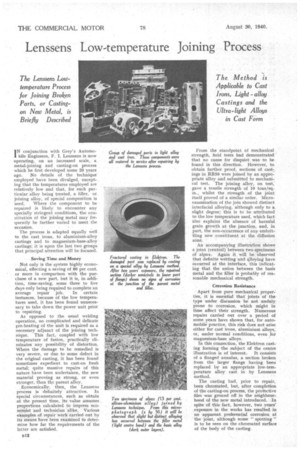Lenssens Low-temperature Joining Process
Page 30

If you've noticed an error in this article please click here to report it so we can fix it.
The Lensserz Lowtemperature Process for Joining Broken Parts, or Castingon New Metal, is Briefly Described The Method is Applicable to Cast Irons, Light alloy Castings and the Ultra-light Alloys in Cast Form
I N conjunction with Grey's Automo
bile Engineers, F. I. Lenssens is now operating, on an increased scale, a metal-joining and casting-on process which he first developed some 20 years ago. No details of the technique employed have been divulged, excepting that the temperatures employed are relatively low and that, for each particular alloy being treated, a filler, OT. joining alloy, of special composition is used. Where the component to be • repaired is likely to encounter any specially stringent conditions, the constitution of the joining metal may frequently be further varied to meet the
occasion.
The process is adapted equally well to the cast irons, to aluminium-alloy castings and to magnesium-base-alloy castings; it is upon the last two groups that principal attention will he focused.
Saving Time and Money Not only is the system highly economical, effecting a saving of 80 per cent. or more in comparison with the purchase of a new part, but it is, in addition, time-saving, some three to five days only being required to complete an average repair job. In certain instances, because of the low temperatures used, it has been found unnecessary to take down the power unit prior to repairing.
As opposed to the usual welding operation, no complicated and delicate pre-heating of the unit is required as a necessary adjunct of the joining technique. This fact, coupled with low temperature of fusion, practically eliminates any possibility of distortion. Where the damage to he remedied is very severe, or due to some defect in the original casting, it has been found sometimes expedient to cast-on fresh metal; quite massive repairs of this nature have been undertaken, the new material proving as strong, or even stronger, than the parent alloy.
Economically, then,. the Lenssens process is definitely attractive. In special circumstances, such as obtain at the present time, its value assumes proportions calculated to impress eco nomist and technician alike. Various examples of repair work carried out by its means have been exarnined to determine how far the requirements of the latter are satisfied,
From the standpoint of mechanical strength, field tests bad demonstrated that no cause for disquiet was to be found in this direction. However, to obtain further proof, sections of cast:, ings in RR50 were joined by an appropriate alloy and submitted to mechanical test. The joining alloy, on test,. gave a tensile strength of 10 tons/sq.. in., whilst the strength .of the joint itself proved of a similar order. Microexamination of the join showed distinct interfacial alloying, although only to a, slight degree; this is to be attributed to the low temperature used, which fact also explains the absence of harmful grain growth at the junction, and, in part, the non-occurrence of any embritding new .constituent at the diffusion
zone. '
An accompanying illustration shows a joint (central) between two specimens of alpax; Again it will be observed that definite wetting and alloying have Occurred at the interface, this indicating that the union between the basis metal and the filler is probably of reasonable mechanical strength.
Corrosion Resistance Apart from pure mechanical properties, it is essential that joints of the type under discussion be not unduly prone to corrosion, which might in time affect their strength. Numerous repairs carried out over a period of some years have shown that, for automobile practice, this risk does not arise either for cast irons, aluminium alloys, or, under normal conditions, even for magnesium-base alloys.
In this connection, the Elektron casting forming the subject of the centre illustration is of interest. It consists of a flanged annulus, a section broken from the larger flange having been replaced by an appropriate low-temperature alloy cast in by Lenssens method.
The casting had, prior to repair, been chromated, but, after completion of the casting-on process; the protective film was ground off in the neighbourhood of the new metal introduced. In spite of this fact, however, two years' exposure in the works has resulted in no apparent preferential corrosion at the joint, although some " spotting" is to be seen on the chromated surface of the body of the casting..




















































